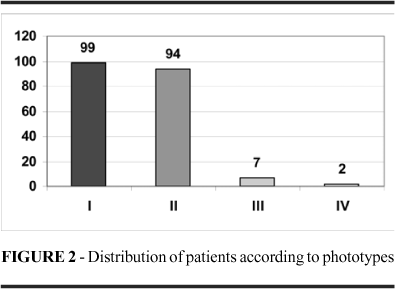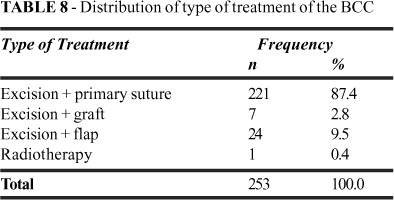PURPOSE: To describe the epidemiological profile of basal cell carcinoma patients at a private hospital in São Paulo and to evaluate the treatment adopted. METHODS: A prospective study of 202 patients, on which 253 lesions were diagnosed for histopathological exam as basal cell carcinoma within the period of January 2001 to September 2003, in the Plastic Surgery Residency Program at the Hospital Jaraguá. The susceptibility factor of the host, the environment variables, the characteristics of the lesions and the efficacy of the treatment were examined. The data were statistically evaluated. RESULTS: The incidence of basal cell carcinoma was 126 cases per 100,000 patients in a period of 32 months (36 cases per 100,000 patients/year). The patients were evenly distributed in terms of sex: 48% male and 52% female. The greater incidence was in patients between the ages of 60 and 80 years and the average was 64 years. The survey revealed susceptibility factors such as white race and phototypes I and II in 95.5% of the patients. Exposition to ultraviolet radiation was reported by 77% of the patients and the most frequent location of tumors was on the face (71.2% of the cases). Actinic keratosis and a history of skin cancer were reported in 43.6% and in 25% of the cases, respectively. The adopted treatment was surgery in 99.4% of the cases and only one patient was treated with radiotherapy. Twenty lesions (8%) had incomplete excision.The recurrence rate was 2% (5 cases). There were no cases with metastasis or fatal outcome. CONCLUSIONS: The factors related to the development of basal cell cancer which were significantly present in the population surveyed were: older age, white individuals, phototypes I and II, presence of actinic keratosis, previous history of non-melanoma skin cancer and exposure to ultra-violet rays both in recreational and in occupational form.The surgical treatment employed was effective with a rate of incomplete excision and recurrence similar to those found in the literature.
Neoplasms, Basal Cell; Skin Neoplasms; Epidemiologic Studies; Urban Population

















